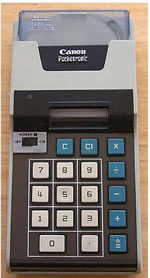Canon Pocketronic Calculator
This collaboration between Canon and Texas Instruments (TI) is the first handheld battery-powered electronic calculator. Introduced in the US in 1971, but a year earlier in Japan, it was preceded by nearly five years by a “skunk-works” project at TI. Before it, electronic calculators were large, heavy machines. Pat Haggerty, then-president of TI, conceived the project and appointed Jack Kilby to lead it. Kilby had developed the first integrated circuit device in 1958. Kilby added to his team Jerry Merryman, a new engineer at TI with expertise in digital design; and James Van Tassel, an expert in the creation of prototype hardware. Van Tassel designed the keyboard. The result was small in size (4” X 6” X 1 ¾ “), weighing just under 3 ½ pounds. It was powered by ni-cad rechargeable batteries which made up 1.8 pounds of the total. The machine printed out to thermal tape, readable through a small plastic magnifying window. It retailed at $345. That same year, other calculators were on the market, including Sharp, Busicom, SCM, Bowmar and Sanyo. By 1975, an avalanche of pocket calculators forced Keuffel & Esser to stop making slide rules, the traditional engineer’s friend since Englishman William Oughtred invented the mechanical tool in 1632. 100 Years of Design consists of excerpts from a book by Carroll M. Gantz, FIDSA, entitled, Design Chronicles: Significant Mass-produced Designs of the 20th Century, published August 2005 by Schiffer Publications, Ltd.
